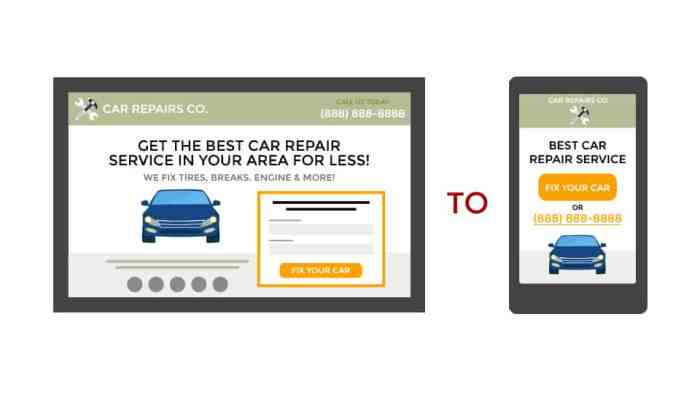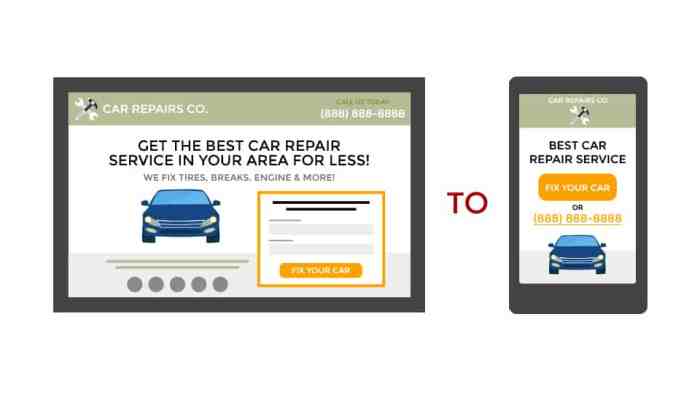Mobile landing page optimization is crucial for modern businesses. It’s not just about having a website that looks good on a phone; it’s about creating a seamless user experience that drives conversions. This in-depth exploration will cover everything from user experience to technical optimization, providing actionable strategies for enhancing your mobile landing pages and boosting your bottom line.
This guide will dissect the key components of a successful mobile landing page. We’ll explore the intricacies of mobile-first design principles, examining how to tailor content and functionality for smaller screens while maintaining a positive user experience. We’ll also look at crucial elements like page speed, intuitive navigation, and effective calls to action to ensure your mobile visitors convert.
Introduction to Mobile Landing Page Optimization
Mobile landing page optimization is the process of designing and refining landing pages to maximize conversions and user engagement on mobile devices. This involves understanding user behavior on smaller screens, optimizing for speed, and ensuring a seamless user experience. Crucially, it goes beyond just making a website viewable; it’s about creating an experience that drives desired actions, like purchases or sign-ups.Mobile-first design principles are essential in landing page optimization because they focus on creating a superior user experience tailored to the limitations and characteristics of mobile devices.
This approach ensures that the page is not just functional, but also intuitive and easy to navigate on smaller screens, which ultimately translates to better user engagement and conversions.
Mobile-First Design Principles
Mobile-first design principles are crucial to landing page optimization. These principles prioritize the mobile experience from the outset, rather than adapting a desktop design for mobile. This approach often results in a cleaner, more user-friendly interface optimized for touchscreens and limited screen real estate.
| Principle | Description | Impact on Optimization |
|---|---|---|
| Prioritize mobile experience | Design the landing page specifically for mobile devices first, then adapt for other screen sizes. | Improved user experience, reduced bounce rate, and increased conversions. |
| Intuitive Navigation | Employ clear and simple navigation elements that are easily accessible on a smaller screen. | Enhanced user experience, reduced friction in completing desired actions. |
| Clear Visual Hierarchy | Employ a clear visual hierarchy to guide users through the page. Use contrasting colors and sizes to highlight important elements like calls-to-action. | Improved user engagement and conversion rates. |
| Optimized for Touch Interactions | Design for touch interactions, ensuring that buttons and links are large enough to tap easily. | Reduced frustration for users, increased conversion rates. |
| Prioritize Page Speed | Optimize the page load time to be as fast as possible. | Improved user experience, decreased bounce rate, increased conversion rates. |
Mobile-Specific vs. Responsive Landing Pages
Mobile-specific landing pages are designed exclusively for mobile devices, optimizing for smaller screens and touch interactions. Responsive landing pages, on the other hand, adapt their layout and content to different screen sizes, including mobile. While responsive design is often a good starting point, mobile-specific design can offer a more tailored and often superior experience for users.
Key Performance Indicators (KPIs) for Mobile Landing Page Success
Tracking KPIs is crucial for evaluating the effectiveness of your mobile landing page optimization efforts. Key metrics to monitor include conversion rate, bounce rate, average session duration, pages per session, and click-through rate (CTR) on mobile-specific elements.
Impact of Page Speed on User Experience and Conversions
Page speed is a critical factor in mobile landing page optimization. Slow loading times lead to a poor user experience, increased bounce rates, and lower conversion rates. Users expect fast loading times on mobile, and failing to meet these expectations can lead to a significant loss in potential customers.
Role of Mobile-Friendly Design in Search Engine Ranking
Mobile-friendly design is a significant factor in search engine rankings. Search engines prioritize mobile-friendly websites, rewarding those with optimized mobile experiences with higher rankings in search results. This is because search engines aim to provide the best possible user experience for their users, and a mobile-friendly website is a critical part of that.
User Experience (UX) Optimization for Mobile
Optimizing mobile landing pages hinges critically on understanding and catering to the unique user experience on smaller screens. Mobile users have different expectations and behaviors compared to desktop users. This requires a tailored approach that prioritizes speed, ease of navigation, and a clear path to conversion. A well-designed mobile landing page can significantly impact user engagement and conversion rates.Mobile users often have limited time and attention spans.
Therefore, a landing page must be designed to quickly capture their attention and guide them toward the desired action. This involves intuitive design choices, quick load times, and a clear visual hierarchy. Focusing on a user-centric approach ensures a positive experience, which is essential for driving conversions.
Key UX Elements for Mobile Landing Pages
Mobile landing pages need to prioritize simplicity and efficiency. Crucial elements include a visually appealing design, clear calls to action, and fast load times. A clean layout that minimizes distractions is essential for maximizing user engagement and conversion rates. The mobile user interface (UI) should be intuitive and easy to navigate, with clear visual cues guiding users through the page.
Optimizing for Mobile-Specific User Behavior
Mobile users often browse on the go, with shorter sessions and a greater reliance on touchscreens. This means the design must be optimized for touch interactions, using large, easily tappable buttons and clear visual hierarchy. Optimizing for touchscreens involves considering factors like finger size and screen resolution. Understanding these nuances is key to a positive user experience and higher conversion rates.
Intuitive Navigation on Mobile Devices
Intuitive navigation is paramount for mobile landing pages. A user should be able to quickly find the information they need and complete desired actions without frustration. This includes a clear sitemap, logical menu structures, and well-placed links. Employing a consistent navigation system across the page creates a seamless user experience. Users should not have to search for information; it should be readily available.
Optimizing mobile landing pages is crucial for user experience. Thinking about how to transform your blog posts can actually help you improve your mobile landing page design. For instance, asking yourself open-ended questions like “What problem am I solving for my users?” and “What’s the single most important call to action?” from the transform your blog posts 6 open ended questions thatll help you create better content guide, forces you to consider the user’s perspective and translate that into a streamlined, mobile-friendly landing page.
This focused approach will ultimately boost conversions.
Improving Mobile Page Load Times
Fast loading times are crucial for mobile user engagement. Slow-loading pages lead to high bounce rates and poor user experience. Optimization strategies include compressing images, minimizing HTTP requests, and leveraging caching mechanisms. Implementing these techniques ensures a smooth and efficient browsing experience. This leads to increased user satisfaction and reduced bounce rates.
Impact of Mobile-Friendly Content Structure on User Engagement
A well-structured mobile landing page can significantly impact user engagement. Content should be concise, easily digestible, and presented in a visually appealing format. Optimizing the content structure includes using short paragraphs, bullet points, and clear headings. The content should be easily scanned and comprehended by mobile users.
Common Mobile UX Issues and Their Solutions
| Issue | Description | Solution |
|---|---|---|
| Slow Load Times | Pages take too long to load, leading to user frustration and abandonment. | Optimize images, minimize HTTP requests, leverage caching, and use a Content Delivery Network (CDN). |
| Poor Navigation | Users struggle to find what they need on the page, leading to confusion and dissatisfaction. | Implement a clear and intuitive navigation menu, use clear visual cues, and ensure a consistent layout. |
| Small Text and Buttons | Text and buttons are too small to easily interact with on mobile screens. | Increase font sizes, use large, tappable buttons, and provide ample spacing between elements. |
| Cluttered Layout | Too many elements on the page make it difficult for users to focus on key information. | Simplify the design, prioritize key information, and use whitespace effectively. |
Mobile-Friendly Call-to-Actions
Clear and prominent calls to action (CTAs) are essential for guiding users toward desired actions. Mobile CTAs should be large, easily tappable, and visually distinct from the surrounding content. This helps to draw the user’s attention to the key action on the page. The CTAs must be easily noticeable and encourage users to take the desired action.
Content Optimization for Mobile: Mobile Landing Page Optimization

Optimizing content for mobile devices is crucial for achieving high engagement and conversion rates. Mobile users expect fast loading times, clear layouts, and concise information. This requires a tailored approach that prioritizes user experience above all else. Effective mobile content strategy focuses on delivering the right message in the right format, making it easily digestible and actionable on smaller screens.Mobile content optimization goes beyond just shrinking a desktop site.
It’s about understanding how users interact with content on their phones and tablets, and adapting accordingly. This includes optimizing text, images, and layout to ensure a smooth and positive experience. Focusing on mobile-specific elements like clear call-to-actions and concise messaging is essential.
Adapting Content for Smaller Screens
Mobile screens present a unique challenge: limited space. To effectively present information, content needs to be streamlined and easily digestible. This involves reducing the amount of text, using larger fonts, and strategically placing elements to avoid clutter. Users should be able to quickly scan and understand the core message. Images and videos should be optimized for quick loading and should be appropriately sized to fit the screen without sacrificing quality.
Effective Mobile Content Strategies
Effective mobile content strategies prioritize user experience. These strategies typically include concise messaging, clear call-to-actions, and mobile-friendly layouts. High-quality images and videos that load quickly are essential. Content should be structured for easy navigation and scanning, with clear hierarchy using headings and subheadings. Examples of effective strategies include mobile-first design, which prioritizes the mobile experience from the start, and A/B testing different content formats to see what resonates best with target audiences.
Importance of Clear and Concise Messaging, Mobile landing page optimization
Mobile users are often on the go and have limited time. Clear and concise messaging is critical for grabbing their attention and conveying the key message quickly. Users should be able to understand the value proposition and take action without extensive reading. Using short, impactful sentences and bullet points can greatly improve comprehension. Strong call-to-actions are vital for encouraging immediate engagement.
Mobile-Specific Headlines and Subheadings
Headlines and subheadings play a vital role in guiding users through the content and breaking up large blocks of text. Mobile-specific headlines should be concise and descriptive, accurately reflecting the content below. They should be large enough to be easily readable on a small screen, yet not so large as to disrupt the overall design. Subheadings should be used to further break down content into digestible chunks, enhancing readability and scannability.
Optimizing Images and Videos for Mobile
Images and videos are important elements for enhancing engagement on mobile. Optimize image files for smaller sizes without sacrificing quality, and ensure quick loading times. Use responsive images that automatically adjust to different screen sizes. For videos, prioritize smaller file sizes while maintaining quality. Compressing videos and using appropriate codecs are crucial for optimal mobile performance.
Also, consider the aspect ratio and cropping to avoid stretching or squeezing the content.
Mobile-Friendly Typography
Clear and legible typography is crucial for a positive user experience on mobile. Choose fonts that are easily readable on smaller screens. Ensure sufficient font sizes to avoid squinting and straining the eyes. Use appropriate line spacing and sufficient contrast between text and background to prevent readability issues.
Mobile-Friendly Content Formats
| Format | Description | Benefits |
|---|---|---|
| Short-form articles | Concise articles focusing on key takeaways. | Easy to scan and read quickly; ideal for mobile users. |
| Infographics | Visual representations of data and information. | Effective for conveying complex information visually; easy to understand at a glance. |
| Videos | Short, engaging video content. | Captivating and easily digestible, especially for demonstrating processes or products. |
| Interactive quizzes | Engaging content with questions and answers. | Improve user engagement and knowledge retention; can also be used to gather user feedback. |
| Carousels | Visually appealing content presented in a series of images or videos. | Easy to navigate and engaging, ideal for showcasing multiple products or services. |
Technical Optimization for Mobile

Optimizing a mobile landing page goes beyond aesthetics and user experience. Technical aspects play a crucial role in ensuring a seamless and efficient mobile browsing experience. A well-structured, technically sound website is critical for conversions and a positive user perception. Ignoring technical optimization can lead to high bounce rates, poor rankings in mobile search results, and ultimately, lost revenue.A mobile-optimized website is not just about making the site look good on a smaller screen; it’s about ensuring swift loading times, easy navigation, and a robust performance that aligns with mobile users’ expectations.
This involves a multi-faceted approach focusing on site structure, viewport settings, responsive design, code efficiency, URL structure, and proactive identification of performance bottlenecks.
Mobile-Friendly Site Structure
A well-organized site structure is vital for mobile optimization. Users expect clear navigation and easy access to information. A logical hierarchy, with intuitive menus and clear pathways, helps users find what they need quickly. This contributes to a positive user experience, especially on smaller screens where space is limited. Mobile-friendly sitemaps should be created and readily accessible to ensure crawlers can easily index the content.
Viewport Settings Optimization
Proper viewport settings are essential for ensuring content displays correctly across various mobile devices. Mobile devices have different screen sizes and resolutions. Incorrect viewport settings can lead to content being scaled incorrectly, cropped, or displayed poorly. Implementing the viewport meta tag, specifying the initial zoom level, and defining the appropriate scaling methods for different screen sizes is critical.
This allows the content to adapt seamlessly to various screen sizes, preventing issues like text being too small or images being stretched or compressed beyond recognition.
Optimizing mobile landing pages is crucial for user experience and conversion rates. I recently dove deep into building and launching a SaaS company, built and launched a SaaS company , and the mobile experience was paramount. A well-designed mobile landing page directly impacts user engagement and ultimately, revenue. Focusing on mobile-first design principles ensures a seamless and positive user journey, leading to higher conversions.
Responsive Design
Responsive design is a cornerstone of mobile optimization. It ensures that the website adapts its layout and content to the specific screen size of the device being used. This adaptability guarantees a consistent and user-friendly experience regardless of the device. Responsive design utilizes flexible grids, fluid images, and media queries to adjust the website’s presentation according to the device’s characteristics.
A responsive design is crucial for maintaining usability and a positive user experience across a range of mobile devices.
Optimizing mobile landing pages is crucial for conversions. A key element in this is understanding how your sales team uses marketing content, like sales team use marketing content , to better understand customer needs and tailor the landing page experience. This ensures your mobile landing page resonates with your target audience and ultimately drives sales.
Mobile-Friendly Code and Development
Optimized code is essential for fast loading times on mobile devices. Excessive code bloat and inefficient coding practices can significantly impact performance. Minimizing code size, using efficient image formats, and optimizing CSS and JavaScript files are crucial steps. Utilizing caching mechanisms, enabling compression, and optimizing server response times can also greatly enhance the mobile experience. By prioritizing lightweight code and efficient development practices, developers ensure fast load times and a seamless user experience on mobile devices.
Mobile-Friendly URLs
Mobile-friendly URLs are concise and user-friendly, making them easily recognizable and memorable. They contribute to a seamless user experience and search engine optimization () by providing clear and understandable links. Short, descriptive URLs, without unnecessary parameters, are crucial. These URLs help users understand the page content and contribute to a positive user experience.
Common Technical Issues Hindering Mobile Performance
Several technical issues can hinder mobile performance, affecting the user experience. Slow server response times, inefficient code, large image files, and ineffective caching are common culprits.
- Slow Server Response Times: Slow server response times significantly impact the loading speed of a website, leading to a frustrating experience for mobile users. This is a major factor in determining the user’s perceived performance. For instance, if a webpage takes over 3 seconds to load, users are more likely to abandon the site.
- Inefficient Code: Inefficient code, often bloated with unnecessary scripts or styles, can slow down the website’s loading time. Using optimized code is crucial for achieving optimal performance on mobile devices. Unoptimized code negatively impacts user experience, potentially resulting in high bounce rates.
- Large Image Files: Large image files are a significant contributor to slow loading times on mobile devices. Compressing images without compromising quality is critical for improving page load times. Using appropriate image formats, such as WebP, is also a key aspect of optimization.
- Ineffective Caching: Poor or non-existent caching mechanisms result in slower loading times. Caching ensures that frequently accessed content is stored locally, improving response times and enhancing the user experience. Caching can drastically improve the loading time of a webpage, especially on mobile devices where network speeds can vary.
Testing and Analysis for Mobile Optimization
Optimizing mobile landing pages isn’t just about creating a visually appealing design; it’s about understanding how users interact with your site on their phones. Thorough testing and analysis are crucial for identifying areas for improvement and maximizing conversions. This involves not only A/B testing but also understanding user behavior, tracking performance metrics, and analyzing the results to inform future iterations.
A/B Testing Mobile Landing Pages
A/B testing is a critical component of mobile optimization. It allows you to compare different versions of your landing page to see which performs better. By testing variations in elements like headlines, calls-to-action (CTAs), images, and layout, you can identify the most effective design choices for your target audience. For example, testing different button colors or placements can significantly impact conversion rates.
Analytics Tools for Mobile Performance Tracking
Numerous analytics tools provide detailed insights into mobile user behavior. Google Analytics, for instance, offers comprehensive data on page views, bounce rates, time on page, and user flow. Using these tools, you can pinpoint bottlenecks in the user journey and identify pages where users are dropping off. Analyzing this data helps in understanding user behavior patterns and optimizing the landing page for improved performance.
Significance of User Testing on Mobile Devices
User testing on mobile devices is essential for understanding how real users interact with your landing page. This direct feedback provides invaluable insights into usability issues, pain points, and areas where the design could be improved. Observing users as they navigate the page allows you to identify areas that might be confusing or frustrating, and refine the experience to better meet their needs.
Methods for Analyzing Mobile User Behavior
Analyzing user behavior involves looking at various metrics beyond basic analytics data. Heatmaps, for example, visualize where users click and scroll on the page, highlighting areas of interest and potential problem areas. Session recordings show users’ actual interactions with the site, offering a clearer picture of how they navigate through the page. These insights can then be used to adjust the design to improve the user experience and encourage conversions.
Methods to Track Conversions on Mobile
Tracking conversions on mobile requires setting up appropriate tracking mechanisms. This often involves using conversion tracking tags to monitor actions like completing a purchase, filling out a form, or signing up for a newsletter. Different analytics tools offer varying methods for this, allowing you to tailor the tracking to specific conversion goals.
Creating a Structured Report Analyzing Mobile Landing Page Performance
A structured report is essential for summarizing mobile landing page performance data. The report should include key metrics like bounce rate, conversion rate, average session duration, and mobile-specific metrics such as page load time. Visualizations like charts and graphs can make the data easier to understand. The report should also highlight areas for improvement, such as addressing slow loading times, improving user flows, or adjusting CTAs.
A well-structured report will offer actionable insights to optimize future mobile landing pages. For example, if bounce rate is high on a specific page, the report should detail why and propose solutions, such as improving page content or simplifying the user flow. This structured approach helps to understand the landing page performance and guides decision-making for optimization.
Mobile Landing Page Design Examples
Mobile landing pages are crucial for driving conversions on mobile devices. Effective design goes beyond aesthetics; it’s about optimizing the user experience for seamless navigation and clear calls to action. This section examines successful mobile landing page designs, dissecting their features, functionalities, and underlying design principles.Understanding how successful mobile landing pages are structured and function allows you to implement these best practices for your own designs, ultimately leading to increased user engagement and conversions.
Examples of Well-Optimized Mobile Landing Pages
Several factors contribute to a well-optimized mobile landing page. These include a clean layout, easy-to-navigate design, and clear calls to action. Effective mobile landing pages prioritize user experience (UX) and adapt to different screen sizes.
Analysis of Design Features and Results
The following table compares two exemplary mobile landing pages, highlighting their design features and their perceived effectiveness. The comparison aims to showcase how different design choices influence user engagement and conversion rates.
| Feature | Example 1 (E-commerce Product Page) | Example 2 (Subscription Service Landing Page) |
|---|---|---|
| Layout | Emphasizes a large, high-quality product image at the top, followed by concise product details, pricing, and a prominent “Add to Cart” button. Minimal distractions. | Clear, visually appealing header with the service’s core value proposition. Easy-to-scan sections showcasing key benefits and features, followed by a prominent sign-up button. |
| Navigation | Intuitive navigation using a simple hamburger menu for access to other product categories and user accounts. | Simple navigation bar with links to pricing plans and frequently asked questions (FAQs). No complex menus or cluttered design. |
| Content | Concise product description, highlighting key features and benefits. Clear pricing information. | Short, compelling copy emphasizing the benefits of the service and its ease of use. |
| Call to Action (CTA) | Large, contrasting “Add to Cart” button, strategically placed below the product details. | Clear, prominent “Start Free Trial” or “Sign Up Now” button, visually distinct from other elements. |
| Responsiveness | Perfectly adjusts to different screen sizes, ensuring optimal readability and usability on various mobile devices. | Auto-adjusts to varying screen sizes, maintaining a clean and functional layout. |
| Results (Estimated) | High conversion rates due to focused design and clear value proposition for the product. Positive user feedback. | High sign-up rates from compelling value proposition, easy-to-use layout, and minimal steps to sign up. Positive user reviews. |
Design Principles Used in Each Example
Example 1 prioritizes a clean, product-focused design, optimizing for conversions through a clear visual hierarchy and immediate call to action. Example 2 emphasizes ease of understanding and scannability to maximize user engagement and encourage subscriptions. Both examples demonstrate a deep understanding of mobile UX principles.
Last Recap
In conclusion, optimizing your mobile landing pages is not a one-size-fits-all endeavor. Success hinges on understanding your target audience, analyzing user behavior, and continuously refining your approach. By implementing the strategies discussed here, you can transform your mobile landing pages into high-converting assets that drive significant results. Remember that a positive mobile experience directly impacts your search engine rankings and ultimately, your business’s success.






